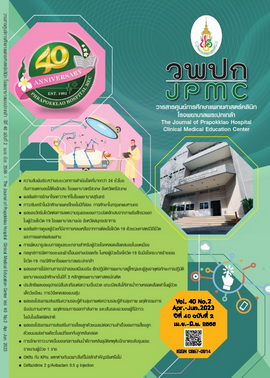The Effectiveness Of A Vibration Device on Pain During Intravenous Infusion in School-aged Pediatric Patients: A Randomized Control Trial
Main Article Content
Abstract
BACKGROUND: Intravenous infusion procedures are some of the most common sources of pain for children in hospital settings. Pain left unmanaged could result in short-term and long-term physiological, psychological and emotional consequences. Several methods exist to reduce pain during intravenous infusions. The purpose of this study was to determine the effectiveness of a vibration device on pain during intravenous infusion in school-aged pediatric patients.
OBJECTIVES: To investigate the effectiveness of a vibration device on pain during intravenous infusion in school-aged pediatric patients.
METHODS: A randomized controlled trial was conducted among 70 Thai children aged 6 to 12 years undergoing intravenous infusion. The children were randomly assigned to either a vibration device group (experimental group) or a normal intravenous infusion group, with 35 children in each group. Data were collected between August 2022 and January 2023. Perception of pain was measured using the Wong-Baker Scale FACES pain Rating (WBS). The data were analyzed using frequency, percentage, mean, standard deviation and Independent t-test.
RESULTS: The experimental group showed significantly (p<0.001) lower levels of mean pain at 1.3±1.6 points compared to the control group at 4.2±2.6 points.
CONCLUSIONS: The vibration device methods were effective in reducing intravenous infusion pain in children.
Article Details

This work is licensed under a Creative Commons Attribution-NonCommercial-NoDerivatives 4.0 International License.
References
Suwantawakup S, Yimjaraen P, Downhampae K. Effects of warm compresses on school-age children’s perception of pain during venipuncture. Thai Journal of Nursing Council 2018; 33(2): 59-69.
Siriboonpipattana P. Pediatric Nursing Vol 1. Nonthaburi:PhraBorom Raj Chanok Institute; 2013.
Kleidon TM, Cattanach P, Mihala G, Ullman AJ. Implementation of a paediatric peripheral intravenous catheter care bundle: a quality improvement initiative. J Paediatr Child Health 2019;55:1214-23.
Schults JA, Kleidon TM, Gibson V, Ware RS, Monteagle E, Paterson R, et al. Improving peripheral venous cannula insertion in children: a mixed methods study to develop the DIVA key. BMC Health Serv Res 2022;22:220.
Bergomi P, Scudeller L, Pintaldi S, Dal Molin A. Efficacy of non-pharmacological methods of pain management in children undergoing venipuncture in a pediatric outpatient clinic: a randomized controlled trial of audiovisual distraction and external cold and vibration. J Pediatr Nurs [Internet]. 2018 [cited 2022 Nov 11];42:e66-e72. Available from: https://www.pediatricnursing.org/article/S0882-5963(21)00003-8/fulltext
Erdogan B, Ozdemir AA. The Effect of three different methods on venipuncture pain and anxiety in children: distraction cards, virtual reality, and buzzy® (randomized controlled trial). J PediatrNurs [Internet]. 2021[ cited 2022 Nov 11];58:e54-e62. Available from: https://linkinghub.elsevier.com/retrieve/pii/S0882-5963(17)30536-5
Juthasantikul W, Junghalogon A, Reangehiraura R, Uakritdathikarn T. Effect of cold alcohol-soaked cotton for pain relieve from intravenous cannulation. Thai Journal of Anesthesiology 2007;33(3):169-75.
Nethan C. Comparison of pain relief from intravenous canulation with normal, cold compression and EMLA methods. Journal of Health Science 2016;25:280-3.
Baxter A. Vibration for chronic pain. Physical Medicine & Rehabilitation [Internet].2019 [cited 2022 Nov 11];19(2). Available from: https://www.practicalpainmanagement.com/treatments/rehabilitation/vibration-chronic-pain
Sanitlou N, Sartphet W, Naphaarrak Y. Sample size calculation using G*Power program. Journal of Suvarnabhumi Institute of Technology 2019;5(1):496-507.
Semerci R, Kocaaslan EN, AkgünKostak M, Akın N. Reduction of pain during intravenous cannulation in children: Buzzy application. Agri 2020;32:177-85.

